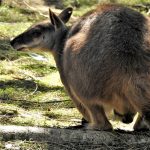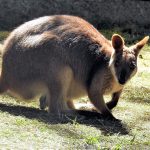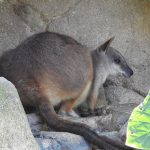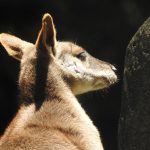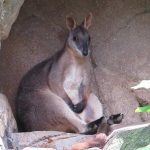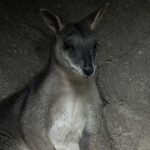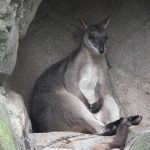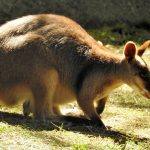PROSERPINE ROCK-WALLABY
In the lush landscapes of Queensland, there exists a remarkable creature known as the Proserpine rock-wallaby. This small marsupial is a testament to the diversity and uniqueness of Australian wildlife. It is one of the rarest wallabies in Australia, with a very limited distribution range.
The Proserpine rock-wallaby is a petite and agile animal, with a body length of about 50 centimetres and a tail that can extend up to 70 centimetres. Its fur is a soft, warm grey with a distinct reddish-brown tinge across its shoulders and back, making it blend seamlessly into the rocky outcrops it calls home. Its face is adorned with a delicate white stripe, adding to its endearing appearance.
This wallaby is endemic to a very restricted area in Queensland, specifically around the Proserpine region. It thrives in rocky habitats, such as cliffs and boulder-strewn hillsides, where it can easily navigate and find shelter. These environments provide both protection from predators and access to the vegetation it feeds upon. They are exceptional climbers, using their strong hind legs and tail for balance and propulsion across rocky terrains.
Proserpine rock-wallabies are primarily herbivorous, with a diet consisting of grasses, leaves, and fruits. They are known to forage at night, using the cover of darkness to avoid predators. Their diet is well-suited to their environment, allowing them to extract moisture from the vegetation, which is crucial during dry seasons.
Breeding for the Proserpine rock-wallaby is a year-round affair, although there tends to be a peak in births during the wetter months when food is more abundant. After a gestation period of about 30 days, a single joey is born, which then makes its way into the mother’s pouch where it continues to develop for several months. Once it leaves the pouch, the young wallaby will still rely on its mother for nourishment and protection until it is fully weaned.
While not particularly vocal, Proserpine rock-wallabies do communicate through a series of soft clicks and clucks, especially during social interactions or when alerting others to potential danger. These subtle sounds help maintain group cohesion and alertness in their rocky habitats.
Proserpine rock-wallabies can live up to 10 years, although this can vary depending on environmental conditions and predation pressures.
The Proserpine rock-wallaby is currently listed as Endangered, primarily due to habitat loss and fragmentation from human activities such as agriculture and urban development. Predation by introduced species like foxes, dogs and feral cats also poses a significant threat. Conservation efforts are crucial to ensure the survival of this unique species. These efforts include habitat restoration, predator control, and the establishment of protected areas.
Through understanding and appreciating the Proserpine rock-wallaby, we can better appreciate the delicate balance of ecosystems and the importance of conserving these unique creatures for future generations. Their survival depends not only on local efforts but on a global appreciation of biodiversity and conservation.

